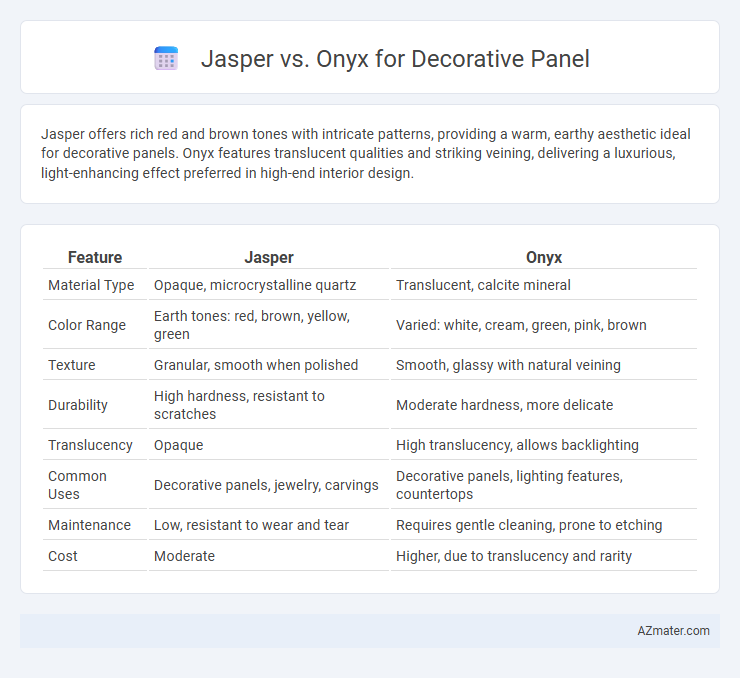Jasper offers rich red and brown tones with intricate patterns, providing a warm, earthy aesthetic ideal for decorative panels. Onyx features translucent qualities and striking veining, delivering a luxurious, light-enhancing effect preferred in high-end interior design.
Table of Comparison
| Feature | Jasper | Onyx |
|---|---|---|
| Material Type | Opaque, microcrystalline quartz | Translucent, calcite mineral |
| Color Range | Earth tones: red, brown, yellow, green | Varied: white, cream, green, pink, brown |
| Texture | Granular, smooth when polished | Smooth, glassy with natural veining |
| Durability | High hardness, resistant to scratches | Moderate hardness, more delicate |
| Translucency | Opaque | High translucency, allows backlighting |
| Common Uses | Decorative panels, jewelry, carvings | Decorative panels, lighting features, countertops |
| Maintenance | Low, resistant to wear and tear | Requires gentle cleaning, prone to etching |
| Cost | Moderate | Higher, due to translucency and rarity |
Introduction to Jasper and Onyx Decorative Panels
Jasper decorative panels feature natural, earthy patterns with warm tones that create a sophisticated, organic ambiance ideal for residential and commercial interiors. Onyx decorative panels stand out for their translucent quality and vivid, striking veining, offering dramatic backlit effects that enhance luxury environments. Both materials are prized for their durability and aesthetic versatility, making them popular choices for feature walls, countertops, and custom decorative installations.
Geological Origins: Jasper vs Onyx
Jasper originates from microgranular quartz and is an opaque variety formed through sedimentary or volcanic processes, often displaying rich, earthy tones with intricate patterns due to mineral impurities. Onyx, a banded form of chalcedony composed of alternating layers of quartz and moganite, forms in hydrothermal environments through the deposition of silica in volcanic or sedimentary cavities, resulting in striking parallel bands in black, white, and brown hues. The distinct geological formation of jasper and onyx directly influences their visual characteristics and suitability for decorative panels, with jasper offering a more opaque, robust texture and onyx providing translucent, layered elegance.
Aesthetic Appeal: Color and Pattern Differences
Jasper decorative panels feature rich, earthy tones with intricate, organic patterns that evoke natural stone, enhancing spaces with warmth and texture. Onyx panels, characterized by their translucent quality and striking veining in vibrant colors, create a luminous, luxurious aesthetic ideal for sophisticated interiors. The contrasting color palettes and patterns of Jasper's muted depth and Onyx's dramatic brilliance cater to diverse design preferences and lighting conditions.
Durability and Hardness Comparison
Jasper and Onyx decorative panels both offer impressive durability, but Jasper is renowned for its higher hardness, scoring around 6.5 to 7 on the Mohs scale compared to Onyx's 3 to 4, making Jasper more resistant to scratches and wear. The dense composition of Jasper contributes to greater longevity in high-traffic areas, while Onyx's softer nature requires more careful maintenance to avoid surface damage. For projects demanding enhanced toughness and prolonged surface integrity, Jasper stands out as the superior choice.
Maintenance Requirements for Jasper and Onyx Panels
Jasper decorative panels require minimal maintenance, needing only regular dusting and occasional cleaning with a mild detergent to preserve their natural veining and vibrant colors. Onyx panels demand more careful upkeep due to their porous nature, requiring sealed surfaces and the use of pH-neutral cleaners to prevent staining and etching. Both materials benefit from professional resealing every 6 to 12 months to maintain their luster and durability in high-traffic areas.
Cost Analysis: Jasper vs Onyx Decorative Applications
Jasper decorative panels typically offer a more cost-effective solution compared to onyx, with prices averaging 20-30% lower due to the relative abundance and easier extraction methods of jasper. Onyx panels, prized for their translucency and striking veining, command a premium price, often reaching $100-$150 per square foot, while jasper ranges between $70-$110 per square foot. Maintenance costs also favor jasper, as onyx requires more frequent sealing and delicate handling to prevent damage, increasing long-term expense.
Popular Uses in Interior Design
Jasper decorative panels are popular for creating warm, natural aesthetics in living rooms and bedrooms due to their rich, earthy tones and textured finishes that mimic natural stone. Onyx panels are favored in luxury interiors such as hotels and upscale kitchens, prized for their translucent quality that allows backlighting to create dramatic, luminous effects. Both materials are widely used for feature walls, countertops, and bathroom accents, enhancing spatial elegance with their unique visual appeal.
Installation Considerations for Jasper and Onyx
Jasper decorative panels offer straightforward installation due to their uniform thickness and durable composite material, which allows for easy cutting and secure mounting on various substrates. Onyx panels require more careful handling and precise fitting because of their natural translucency and variation in thickness, often necessitating specialized adhesives and backlighting considerations to enhance their visual appeal. Both materials demand professional installation to preserve the integrity and aesthetic quality of the panels, though Jasper is typically favored for quicker, more cost-effective installation projects.
Environmental Impact of Mining and Processing
Jasper and Onyx both require extensive mining processes that impact the environment, with Jasper mining often involving more aggressive extraction techniques that lead to greater habitat disruption and increased carbon emissions. Onyx processing demands high energy consumption due to its delicate layering, which elevates its overall carbon footprint compared to Jasper. Sustainable sourcing and eco-friendly processing technologies are critical in reducing the environmental impact associated with both materials in decorative panel production.
Choosing the Right Stone: Jasper or Onyx for Your Space
Choosing between Jasper and Onyx for decorative panels depends on the desired aesthetic and durability requirements. Jasper offers vibrant, earthy tones with unique patterns, making it ideal for warm, natural-themed interiors, while Onyx provides a translucent, elegant appearance perfect for backlit installations and luxurious spaces. Consider factors such as light transmission, hardness, and maintenance needs to select the stone that best complements your design vision and functional demands.

Infographic: Jasper vs Onyx for Decorative Panel
 azmater.com
azmater.com